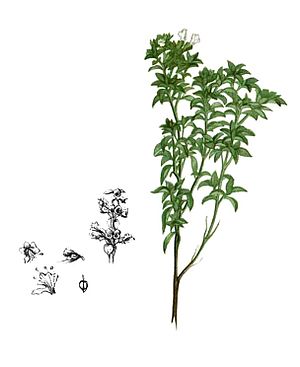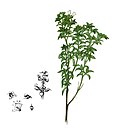Note: This is a project under development. The articles on this wiki are just being initiated and broadly incomplete. You can Help creating new pages.
Difference between revisions of "Ocimum canum"
(Created page with "{{stub}} ==Uses== {{Uses|}}, {{Uses|}}, {{Uses|}}, {{Uses|}}, {{Uses|}}, {{Uses|}}, {{Uses|}}, {{Uses|}}, {{Uses|}}, {{Uses|}}, {{Uses|}}.<ref name="Uses"/> ==Parts Used== {{...") |
|||
| (8 intermediate revisions by the same user not shown) | |||
| Line 1: | Line 1: | ||
| − | + | [[File:Ocimum canum Blanco2.257.jpg|thumb|right]] | |
| + | '''Ocimum Canum''' belongs to the Lamiaceae family. This annual plant is native to the African continent and grows to a height of 2 feet. It is also known as the African basil with a distinct mint flavor, with hairy leaves and scented flowers. | ||
==Uses== | ==Uses== | ||
| − | {{Uses|}}, {{Uses|}}, {{Uses|}}, {{Uses|}}, {{Uses|}}, {{Uses|}}, {{Uses| | + | {{Uses|Colds}}, {{Uses|Fevers}}, {{Uses|Parasitic infestations}}, {{Uses|Headaches}}, {{Uses|Inflammation of joints}}, {{Uses|Dysentary}}, {{Uses|Tooth problems}}.<ref name="Uses"/> |
==Parts Used== | ==Parts Used== | ||
| − | {{Parts Used| | + | {{Parts Used|Whole herb}}. |
==Chemical Composition== | ==Chemical Composition== | ||
| − | <ref name="chemical composition"/> | + | It contains following Chemical constituents Thymol (42.15%), p-cymene (21.17%) and γ-terpinene (19.81%) as major compounds<ref name="chemical composition"/> |
==Common names== | ==Common names== | ||
| − | {{Common names|sa=|en=|gu=|hi=|kn=|ks=|ml=|mr=|pa=|ta=|te=}} | + | {{Common names|sa=Ajaka|en=Wild basil|gu=|hi=Kala Tulasi|kn=Nayi tulasi|ks=|ml=Katturamatulasi|mr=|pa=|ta=Nay Tolasi|te=Kukka Tulasi}}<ref name="Karnataka Medicinal Plants"/> |
==Properties== | ==Properties== | ||
| Line 16: | Line 17: | ||
===Dravya=== | ===Dravya=== | ||
===Rasa=== | ===Rasa=== | ||
| − | |||
===Guna=== | ===Guna=== | ||
| Line 33: | Line 33: | ||
==Identification== | ==Identification== | ||
===Leaf=== | ===Leaf=== | ||
| − | {{Leaf|||}}<ref name="Leaf"/> | + | {{Leaf|Elliptic|Pointed to tapering|Base flat or blunt, Nearly entire}}<ref name="Leaf"/> |
===Flower=== | ===Flower=== | ||
| − | {{Flower||||}} | + | {{Flower|Borne in racemes|5mm long|White||Densely velvet hairy, Filaments hairless. Flowering season is August}} |
===Fruit=== | ===Fruit=== | ||
| − | {{Fruit||||||}} | + | {{Fruit|Nutlets|1.5mm long|Sub trigonous|Minutely fitted|Dark brown|Fruiting season is August}} |
===Other features=== | ===Other features=== | ||
| Line 51: | Line 51: | ||
==How to plant/cultivate== | ==How to plant/cultivate== | ||
| − | <ref name="How to plant/cultivate"/> | + | It flourishes in conditions of lot of sun, well drained soils and access to heat.<ref name="How to plant/cultivate"/> |
==Commonly seen growing in areas== | ==Commonly seen growing in areas== | ||
| Line 58: | Line 58: | ||
==Photo Gallery== | ==Photo Gallery== | ||
<gallery class="left" caption="" widths="140px" heights="140px"> | <gallery class="left" caption="" widths="140px" heights="140px"> | ||
| − | + | File:Ocimum canum Blanco2.257.jpg | |
</gallery> | </gallery> | ||
| Line 64: | Line 64: | ||
<references> | <references> | ||
| − | <ref name="chemical composition"> | + | <ref name="chemical composition">Industrial Crops and Products Volume 119, Pages 201-208</ref> |
| − | <ref name="Leaf"> | + | <ref name="Leaf">Kappatagudda - A Repertoire of Medicianal Plants of Gadag by Yashpal Kshirasagar and Sonal Vrishni, Page No. 283</ref> |
| + | |||
| + | <ref name="How to plant/cultivate">[Cultivation]</ref> | ||
| − | |||
<ref name="Uses">Indian Medicinal Plants by C.P.Khare</ref> | <ref name="Uses">Indian Medicinal Plants by C.P.Khare</ref> | ||
| + | |||
| + | <ref name="Karnataka Medicinal Plants">"Karnataka Medicinal Plants Volume - 2" by Dr.M. R. Gurudeva, Page No.756, Published by Divyachandra Prakashana, #45, Paapannana Tota, 1st Main road, Basaveshwara Nagara, Bengaluru. </ref> | ||
</references> | </references> | ||
==External Links== | ==External Links== | ||
| − | * [ ] | + | * [https://plants.jstor.org/compilation/ocimum.canum Ocimum canum on plants.jstor.org] |
| − | + | ||
| − | |||
[[Category:Herbs]] | [[Category:Herbs]] | ||
| + | [[Category:Pages without herbs images]] | ||
Latest revision as of 11:28, 13 August 2023
Ocimum Canum belongs to the Lamiaceae family. This annual plant is native to the African continent and grows to a height of 2 feet. It is also known as the African basil with a distinct mint flavor, with hairy leaves and scented flowers.
Contents
- 1 Uses
- 2 Parts Used
- 3 Chemical Composition
- 4 Common names
- 5 Properties
- 6 Habit
- 7 Identification
- 8 List of Ayurvedic medicine in which the herb is used
- 9 Where to get the saplings
- 10 Mode of Propagation
- 11 How to plant/cultivate
- 12 Commonly seen growing in areas
- 13 Photo Gallery
- 14 References
- 15 External Links
Uses
Colds, Fevers, Parasitic infestations, Headaches, Inflammation of joints, Dysentary, Tooth problems.[1]
Parts Used
Chemical Composition
It contains following Chemical constituents Thymol (42.15%), p-cymene (21.17%) and γ-terpinene (19.81%) as major compounds[2]
Common names
| Language | Common name |
|---|---|
| Kannada | Nayi tulasi |
| Hindi | Kala Tulasi |
| Malayalam | Katturamatulasi |
| Tamil | Nay Tolasi |
| Telugu | Kukka Tulasi |
| Marathi | |
| Gujarathi | |
| Punjabi | |
| Kashmiri | |
| Sanskrit | Ajaka |
| English | Wild basil |
Properties
Reference: Dravya - Substance, Rasa - Taste, Guna - Qualities, Veerya - Potency, Vipaka - Post-digesion effect, Karma - Pharmacological activity, Prabhava - Therepeutics.
Dravya
Rasa
Guna
Veerya
Vipaka
Karma
Prabhava
Habit
[[:Category:Habit - |]]
Identification
Leaf
| Kind | Shape | Feature |
|---|---|---|
| Elliptic | Pointed to tapering | Base flat or blunt, Nearly entire |
Flower
| Type | Size | Color and composition | Stamen | More information |
|---|---|---|---|---|
| Borne in racemes | 5mm long | White | Densely velvet hairy, Filaments hairless. Flowering season is August |
Fruit
| Type | Size | Mass | Appearance | Seeds | More information |
|---|---|---|---|---|---|
| Nutlets | 1.5mm long | Sub trigonous | Minutely fitted | Dark brown | Fruiting season is August |
Other features
List of Ayurvedic medicine in which the herb is used
Where to get the saplings
Mode of Propagation
[[:Category:Index of Plants which can be propagated by |]]
How to plant/cultivate
It flourishes in conditions of lot of sun, well drained soils and access to heat.[5]
Commonly seen growing in areas
[[:Category:Herbs that are commonly seen in the region of |]], [[:Category:Herbs that are commonly seen in the region of |]], [[:Category:Herbs that are commonly seen in the region of |]], [[:Category:Herbs that are commonly seen in the region of |]], [[:Category:Herbs that are commonly seen in the region of |]].
Photo Gallery
References
- ↑ Indian Medicinal Plants by C.P.Khare
- ↑ Industrial Crops and Products Volume 119, Pages 201-208
- ↑ "Karnataka Medicinal Plants Volume - 2" by Dr.M. R. Gurudeva, Page No.756, Published by Divyachandra Prakashana, #45, Paapannana Tota, 1st Main road, Basaveshwara Nagara, Bengaluru.
- ↑ Kappatagudda - A Repertoire of Medicianal Plants of Gadag by Yashpal Kshirasagar and Sonal Vrishni, Page No. 283
- ↑ [Cultivation]
External Links
- Ayurvedic Herbs known to be helpful to treat Colds
- Ayurvedic Herbs known to be helpful to treat Fevers
- Ayurvedic Herbs known to be helpful to treat Parasitic infestations
- Ayurvedic Herbs known to be helpful to treat Headaches
- Ayurvedic Herbs known to be helpful to treat Inflammation of joints
- Ayurvedic Herbs known to be helpful to treat Dysentary
- Ayurvedic Herbs known to be helpful to treat Tooth problems
- Herbs with Whole herb used in medicine
- Herbs with common name in Kannada
- Herbs with common name in Hindi
- Herbs with common name in Malayalam
- Herbs with common name in Tamil
- Herbs with common name in Telugu
- Herbs with common name in Sanskrit
- Herbs with common name in English
- Habit -
- Index of Plants which can be propagated by
- Herbs that are commonly seen in the region of
- Herbs
- Pages without herbs images

